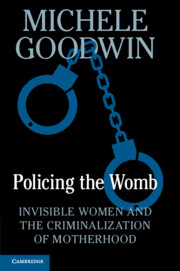Book contents
- Policing the Womb
- Policing the Womb
- Copyright page
- Dedication
- Contents
- Preface
- Acknowledgments
- 1 Introduction
- 2 Pregnancy and State Power
- 3 Creeping Criminalization of Pregnancy across the United States
- 4 Abortion Law
- 5 Changing Roles of Doctors and Nurses: Hospital Snitches and Police Informants
- 6 Revisiting the Fiduciary Relationship
- 7 Creating Criminals: Race, Stereotypes, and Collateral Damage
- 8 The Pregnancy Penalty: When the State Gets It Wrong
- 9 Policing Beyond the Border
- 10 Lessons for Law and Society: A Reproductive Justice New Deal or Bill of Rights
- 11 Conclusion
- Epilogue
- Notes
- Select Bibliography
- Index
1 - Introduction
Published online by Cambridge University Press: 07 February 2020
- Policing the Womb
- Policing the Womb
- Copyright page
- Dedication
- Contents
- Preface
- Acknowledgments
- 1 Introduction
- 2 Pregnancy and State Power
- 3 Creeping Criminalization of Pregnancy across the United States
- 4 Abortion Law
- 5 Changing Roles of Doctors and Nurses: Hospital Snitches and Police Informants
- 6 Revisiting the Fiduciary Relationship
- 7 Creating Criminals: Race, Stereotypes, and Collateral Damage
- 8 The Pregnancy Penalty: When the State Gets It Wrong
- 9 Policing Beyond the Border
- 10 Lessons for Law and Society: A Reproductive Justice New Deal or Bill of Rights
- 11 Conclusion
- Epilogue
- Notes
- Select Bibliography
- Index
Summary
This is not a work of fiction, although I wish it were. Some of the cases described here could recall the imagery evoked by Mary Shelly, author of Frankenstein; or, The Modern Prometheus, who tells a horror story about a young rogue scientist who creates an unsightly monster through clandestine, aberrant experimentation. Although Frankenstein is the name of the monster’s creator, Dr. Victor Frankenstein, readers would be forgiven for debating who the real monster happens to be. In Policing the Womb, the story of Marlise Muñoz comes to mind. Brain-dead, decomposing in a Texas hospital, forced by state legislation to gestate a barely developing fetus while her body decays and the anomalies in the fetus mount. Eventually, it will be reported that the fetus is hydrocephalic, which means severe brain damage in this case and water or fluid developing on its brain. Medical reports will also show that the fetus is not developing its lower extremities. The state knows brain death is irreversible.
- Type
- Chapter
- Information
- Policing the WombInvisible Women and the Criminalization of Motherhood, pp. 1 - 11Publisher: Cambridge University PressPrint publication year: 2020

